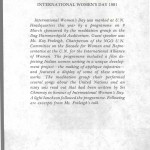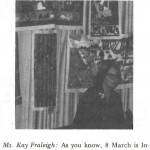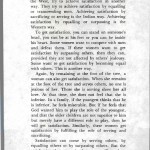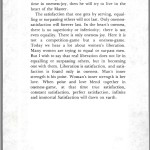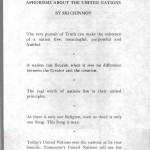International Women’s Day Prog 9 Mar 1981
Filed under Thoughts from the UN community. | UN Anniversaries1981 International Women’s Day was marked at U.N. Headquarters this year by a programme on 9 March sponsored by the meditation group in the Dag Hammarskjold Auditorium. Guest speaker was Ms. Kay Fraleigh, Chairperson of the NGO U.N. Committee on the Decade for Women and Representative at the U. N. for the International Alliance of Women. The programme included a film depicting Indian women uniting in a unique development project-the making of applique tapestries-and featured a display of some of these artistic works. The meditation group choir performed several songs about the United Nations and an essay was read out that had been written by Sri Chinmoy in honour of International Women’s Day. A light luncheon followed the programme. Following are excerpts from Ms. Fraleigh’s talk
Ms. Kay Fraleigh: As you know, 8 March is In-ternational Women’s Day. On 8 March 1908 women needle trade workers marched for more humane working conditions in New York City. At the second International Women’s Conference held in Copenhagen in 1910 Clara Zerkin proposed the idea of an International Women’s Day based on the model that had been given in the United States. The delegates then were optimistic about the possible success of this new commemorative day. This day, 8 March, has been associated not so much with the feminist effort toward gaining political rights as it has been with the class struggle or workers’ struggle. It has been particularly associated with the movement for peace in a socialist world. This could be expected because the women’s movement has always had elements of other struggles in it as well. For instance, in the United States the Abolitionist movement was strongly supported by women like Julia Ward Howe and Lucy Stone (the woman who wouldn’t pay her taxes because she didn’t have the right to vote and ~ho also kept her own name when she was married because she didn’t feel it was right to lose her identity). In one respect the organised demand for political equality in Europe and the United States was a middle-class movement. As the women of the world gathered strength through international organisations and conferences, we began to have the feeling of an inter-national women’s movement. The international women’s organisations, therefore, have over three quarters of a century’s experience in their efforts towards advancing the cause of women. Individual governments have now appointed women’s bureaus and women’s commissions. On the international level, the United Nations has a Status of Women Commission. It was founded in 1946 when only half of the sovereign nations had extended women the right to vote. The women who were representatives on this commission were judges and social workers, educators and so on. Their main efforts initially were to promote women’s rights in the political, economic, social and civil fields. Their object was to implement international agreements and conventions and to develop proposals to give effect to such recommendations. They had many studies, of course. In 1962 a General Assembly resolution invited the Commission to cooperate with the Secretary-General in a study which would focus on the possibility of expanding assistance for women in developing countries. In 1967 the Declaration on Elimination of All Forms of Discrimination against Women was passed. Here we have the seeds of the international women’s movement as we have it today.
In 1975 we had the Mexico City Conference with its themes of equality, development and peace. Out of the Copenhagen Conference in 1980 came the Plan of Action and much good work. Now it is much more difficult for women as we work for human rig ts an d for our own advancement be-cause of the economic condition of the world, the rise of national movements and the effort toward liberation. And we have found that while one can change laws, attitudes are not so easily changed. In 1980 we have t h e firs t Decade for Women, the Second Decade for Disarmament and the Third Decade for Development. Perhaps now we are better able to see t h e link between these three concerns and we have become better able to form net-works out of different women’s movements. On a personal level, I feel we h ave also come to a turning point. Women have always been asked to do six things at the same time and to do them well. We have been asked to be everything to everyone and to be the nurturers of our world. We need to help men to understand that they also need to be the nurturers of our world and, in fact, they are. It is just that they haven’t had the opportunity to play this role as much as women have. Hopefully when we come to the end of the Decade for Women, we will have formed a better partnership. Partnership is an old fashioned word, but I really believe that it is necessary, that if we don’t develop more of an understanding of what equality truly means, we won’t really succeed in this Decade for Women.
note also 1978 concert and dinner
Dinner in Honour of International Women’s Day 1978 Mar
Gallery:

